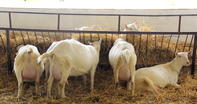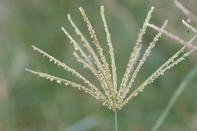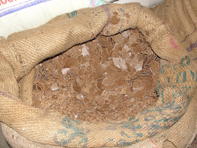Feeds for goats are traditionally classified into three categories - Roughage, Concentrates and Supplements: Roughage - high in fibre feeds, low digestibility, less expensive than other feeds.

Roughages are bulky feeds that are high in fibre, such as grass, hay, lucerne, pastures, leaves, crop residues. Concentrates - nutrients are more concentrated than in roughages, and are usually more expensive. Supplements - consisting of vitamins or minerals, supplements are included in small quantities with the main food ingredients, to ensure that all required nutrients are supplied.
Roughage for Goats

Roughage is any feed ingredient with a high level of fiber that breaks down slowly. The best roughage has long coarse fibers such as cottonseed, soybean and oat hulls, any type of hay and fresh forage. (Feed pellets contain fibre, but not roughage.) Grain-based feeds are lower in roughage than forage or pastures, which are 100% roughage.
A goat is rather like a small dairy cow, a ruminant, and should have enough roughage in its diet, so that it can "chew the cud" (ruminate). Roughages must make up the basis of a feeding programme for goats. Without roughages, the goats will die. Dairy goats need fibre for good rumen action and normal milk fat levels.
Limiting a doe's fibre intake will limit her milk yield. If there is enough roughage of good quality, then it is possible that some types of goats can get all the nutrients they need from the roughage, except perhaps for some vitamins and minerals. The cheapest way is to produce home-grown roughages, especially if transport costs are high.
You will save money, but will also be assured of the quality and availability. Also, keep a supply of roughages in storage (as hay or silage) for those times of drought.
For example, you may be able to grow some pasture like Rhodes grass for the summer and plant oats to cut or graze for winter fodder. These give bulk and a certain amount of energy, but are relatively low in protein, especially as the plants mature. Lucerne, cowpeas and other legumes are excellent as sources of good quality protein.
Concentrate Feeds for Goats

Concentrates are feed sources that may be added to a basic roughage diet. If the roughage is of good quality and tastes good, less concentrate will be needed than when a roughage is of poor quality or is unpalatable.
The goat can increase its nutrient supply by eating more roughage and by using up body reserves (fat), but when an animal is production milk or growing, it is necessary to give a more concentrated form of feed.
Concentrates can be divided into two broad categories: Sources of energy - maize and other grains Sources of protein - fish meal, soybean oil cake meal, sunflower oilcake meal, groundnut oilcake meal, cottonseed oilcake meal, etc. Usually, these ingredients are blended to supply the required balance of nutrients.
Concentrates are expensive, so their use must be restricted so as not to waste money. Concentrates are generally purchased from a feed supplier, but can also be homemade by the farmer. It is important to get a nutritionist to formulate the mix and should include a vitamin/mineral premix to supply essential nutrients. However, it will often be simplest to purchase a standard dairy meal instead of having one specially mixed.
Complete Feeds for Goats
It is possible to feed "complete feeds" to dairy goats, in which all the necessary feeds are included in one mix: roughages, concentrates, vitamins and minerals all mixed together. These are also called "Total Mixed Rations" (TMR). Complete feeds should be supplied freely so they can eat as much as they want.
However, high-yielding dairy goats (+4 litres of milk /day) will probably need extra energy. Supplying complete feeds may be a viable solution for farmers that can produce it at an economical price, especially for farmers who cannot produce home-grown roughages.
One practical difficulty, especially with goats, is that they may eat only certain ingredients in the TMR, the more tasty bits. This means they might not eat a balanced diet, or eat enough roughage and will then run the risk of developing acidosis. (Acidosis develops when ruminants eat too much grains and not enough fibrous material.
This causes fermentation and the rumen to shut down.) Please note: Information is for educational and informational purposes only and may not be construed as feeding or nutritional advice. For more information on feeding your goats contact your animal health technician, veterinarian or animal feed supplier.
By Marinda Louw